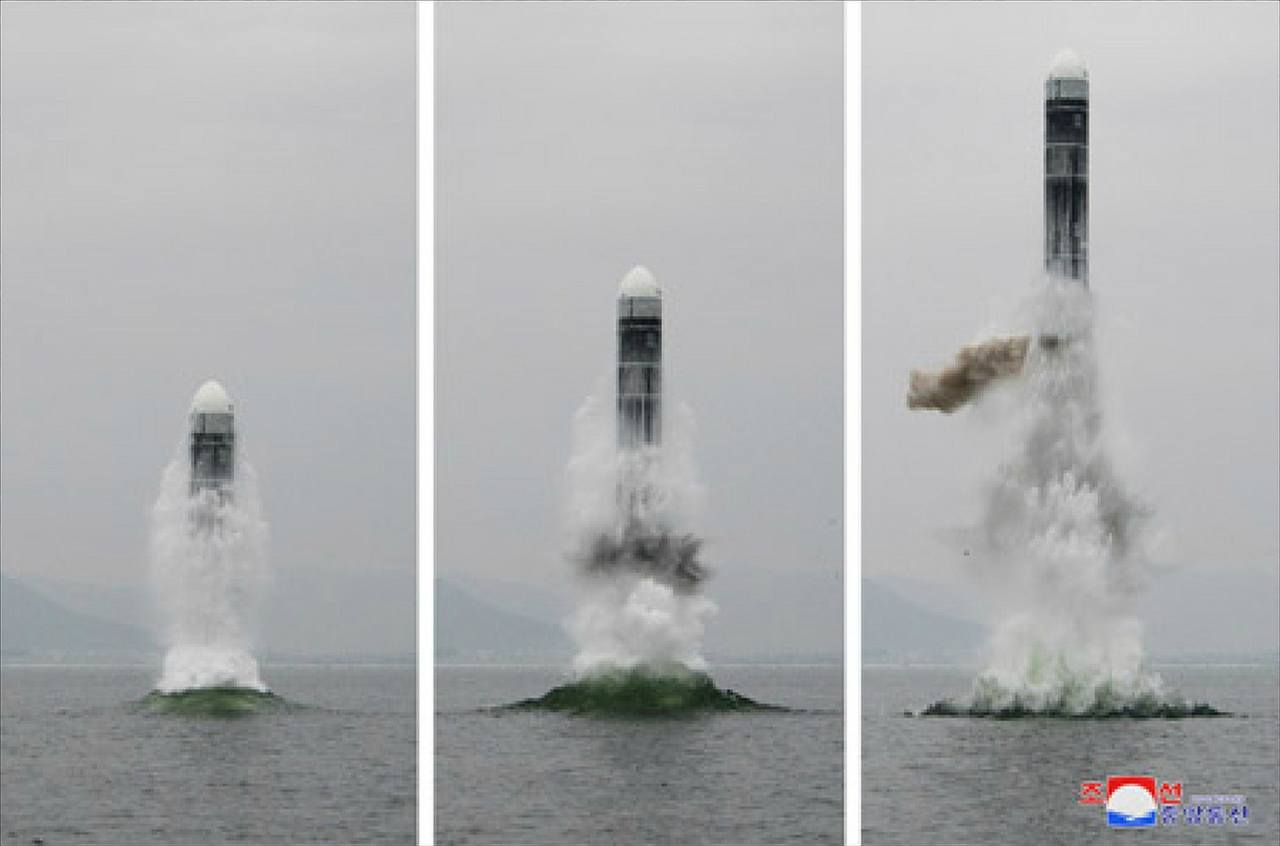 |
(KCNA-Yonhap) |
WASHINGTON -- North Korea's acquisition of submarine launched ballistic missile (SLBM) capabilities will further complicate international efforts to denuclearize the communist state, a former US defense official said Tuesday, highlighting the need to address the issue in future negotiations aimed at denuclearizing the communist state.
Peter Brookes, a former deputy assistance secretary of defense for Asian and Pacific affairs, notes North Korea's ballistic missile submarine (SSB) may also be on the horizon.
"Like its ascension into the once-exclusive nuclear weapons club in 2006, the SSB/SLBM program, if successful, will again elevate North Korea into a small group of countries with SLBM capability, providing domestic and international notoriety to the regime," Brookes said in a report published by the Heritage Foundation.
"The benefits that will almost certainly accrue to Pyongyang from its successful development and likely eventual deployment of an SSB program and a likely nuclear-armed SLBM will complicate dealing with the rogue state," he added.
The former Pentagon official currently serves as a senior research fellow at the Washington-based think tank.
North Korea has long been suspected of developing SLBMs, while many suspect the communist state may soon unveil a new weapons system, possibly a nuclear-armed SLBM, to mark the 75th founding anniversary of its ruling Workers' Party, which falls on this Saturday.
Brookes said North Korea's submarine fleet is already said to be one of the largest, "though not the most capable" in the world, with an estimated 80 submarines that he said run 'alongside the United States and China in numbers."
Most North Korean submarines are said to be diesel-powered and "acoustically noisy," which makes them easy to detect, according to Brookes.
Still, the former Pentagon official insisted a North Korean submarine capable of launching nuclear-armed SLBMs would sharply increase its threats to the United States and its allies, including South Korea and Japan, while also expanding its leverage in denuclearization negotiations.
"An increase in the SLBM's range or the deployment range of SSBs beyond home waters would increase the threat beyond Northeast Asia to include Guam, Hawaii, and Alaska. An SLBM with ICBM range would threaten the continental United States," wrote Brookes.
In October 2019, the North successfully tested a SLBM, the Pukguksong-3, which climbed to 950 kilometers above the Earth's surface and traveled 450 kilometers before falling into the East Sea.
If fired on a standard missile trajectory, the missile would have traveled some 2,000 kilometers, Brookes notes.
"To counter the threat that this program presents once it becomes fully operational, the United States and its allies will have to adjust their intelligence coverage, missile defense capabilities, and anti-submarine warfare duties, among other things," he said.
US Defense Secretary Mark Esper later laid out his country's plan to build a "larger and more capable submarine force," citing a recent study by the Defense Department, titled Battle Force 2045 that mostly deals with growing threats from the Chinese military.
"The study reached a clear consensus on the need to rapidly increase our attack submarines, the most survivable strike platform in a future great power conflict to the range of 70 to 80 in the fleet," he said in a webinar hosted by the Washington-based Center for Strategic & Budgetary Assessments.
To this end, the US must begin building at least three Virginia-class nuclear-powered fast attack submarines a year as soon as possible, he said.
"We will continue to modernize the undersea strategic deterrent, the most survivable leg of the new nuclear triad," added Esper, referring to the country's land, air and sea-based nuclear capabilities.
Brookes reiterated the threat and complication North Korea's successful acquisition of a "nuclear dyad" of land and sea-based capabilities would bring.
"The deepening and diversification of the DPRK's nuclear arsenal from a monad to a dyad would increase the overall military threat from North Korea and could complicate US and allied policymaking, strategic deterrence, and ongoing diplomatic efforts to denuclearize the Korean Peninsula," he said, referring to the communist state by its official name, the Democratic People's Republic of Korea.
He underlined the need to include the North's SLBM program in future denuclearization talks with the communist state.
"While talks about denuclearizing the Korean Peninsula go back decades with less than optimum results, diplomatic efforts aimed at promoting peace and reconciliation on the Korean Peninsula must still be pursued. North Korea's SLBM program should be included in any future nuclear negotiations, assuming that the SLBM is a strategic weapon," said Brookes.
US-North Korea denuclearization talks have stalled since early 2019 when their second bilateral summit held in Hanoi ended without a deal.
US President Donald Trump and North Korean leader Kim Jong-un met again in June that year but only briefly and without any progress.
Their first summit was held in Singapore in June 2018. (Yonhap)




![[Herald Interview] 'Trump will use tariffs as first line of defense for American manufacturing'](http://res.heraldm.com/phpwas/restmb_idxmake.php?idx=644&simg=/content/image/2024/11/26/20241126050017_0.jpg)

![[Health and care] Getting cancer young: Why cancer isn’t just an older person’s battle](http://res.heraldm.com/phpwas/restmb_idxmake.php?idx=644&simg=/content/image/2024/11/26/20241126050043_0.jpg)

